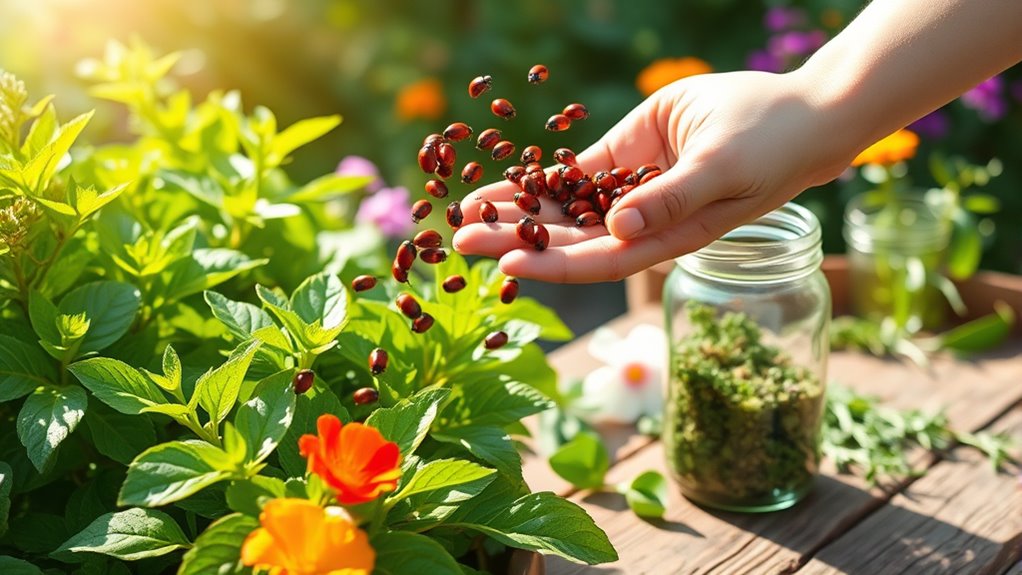Instead of relying solely on DIY traps, generic remedies, or quick fixes, focus on addressing the root causes of pests by improving sanitation, sealing entry points, and removing clutter. Prioritize pest prevention through healthy soil, diverse plants, and supporting beneficial insects. Proper identification and understanding pest behavior help choose targeted, eco-friendly solutions. Relying on a holistic, integrated approach guarantees long-term success—continue exploring ways to create resilient, pest-resistant ecosystems.
Key Takeaways
- Stop relying solely on DIY traps; address root causes like habitat and sanitation for long-term pest management.
- Avoid chemical pesticides; instead, promote ecosystem health and beneficial insects to naturally suppress pests.
- Do not neglect pest identification; research pest behavior and lifecycle to implement targeted, effective solutions.
- Refrain from using single-method approaches; integrate biological, cultural, and physical controls for holistic pest control.
- Stop ignoring soil and plant health; build resilience through proper care and soil management to prevent pest infestations.
Relying Solely on DIY Traps Without Addressing the Root Cause

While DIY traps can catch some pests temporarily, relying on them alone won’t solve your pest problem in the long run. To truly eliminate pests, you need to perform a root cause analysis to identify what’s attracting or enabling their presence. Without understanding the underlying issue, traps become a futile Band-Aid. Focus on habitat modification to make your environment less appealing to pests—seal entry points, remove food sources, and eliminate clutter. These steps target the root cause of infestations rather than just capturing pests after they arrive. Additionally, understanding the importance of contrast ratio can help you optimize your pest control environment for better visibility and detection. By addressing the root problem, you prevent new pests from entering and reduce reliance on traps. Remember, effective pest control involves understanding why pests are there in the first place and changing the environment accordingly.
Using Generic Pesticides Without Proper Identification
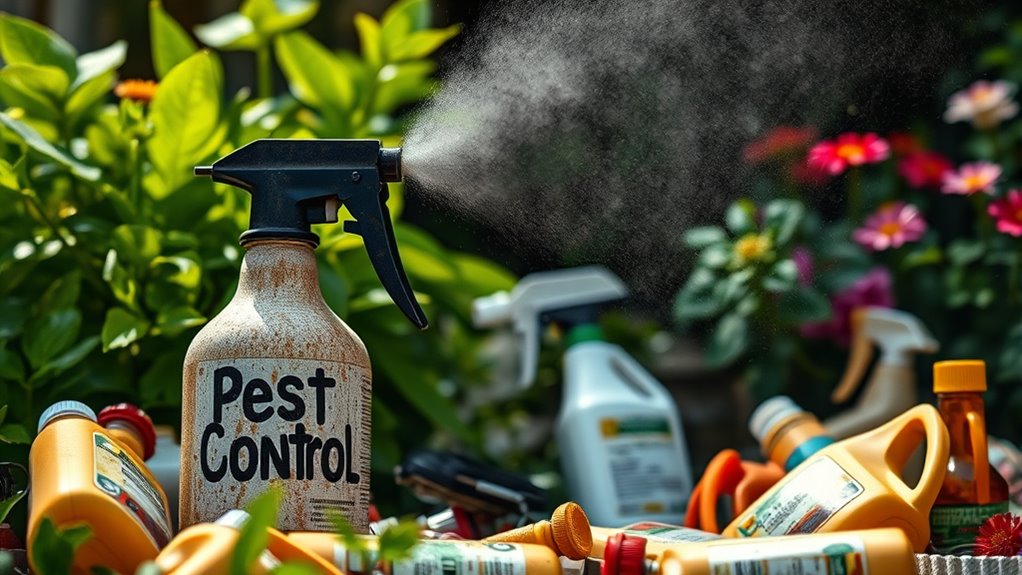
Using generic pesticides without proper identification can do more harm than good. Pesticide misuse is a common mistake, leading to ineffective results and potential health risks. Without knowing the specific pest you’re targeting, you might choose a product that doesn’t work or worsens the problem. Relying on generic pesticides also overlooks trap limitations; traps alone often can’t identify the pest accurately or control widespread infestations. Applying the wrong pesticide can kill beneficial insects and disrupt your garden’s balance. Always identify the pest first, then select a targeted, environmentally friendly solution. Proper identification is key to safe, effective, and sustainable pest management. Additionally, understanding water management techniques can help prevent pest issues related to excess moisture.
Ignoring Prevention and Sanitation Measures
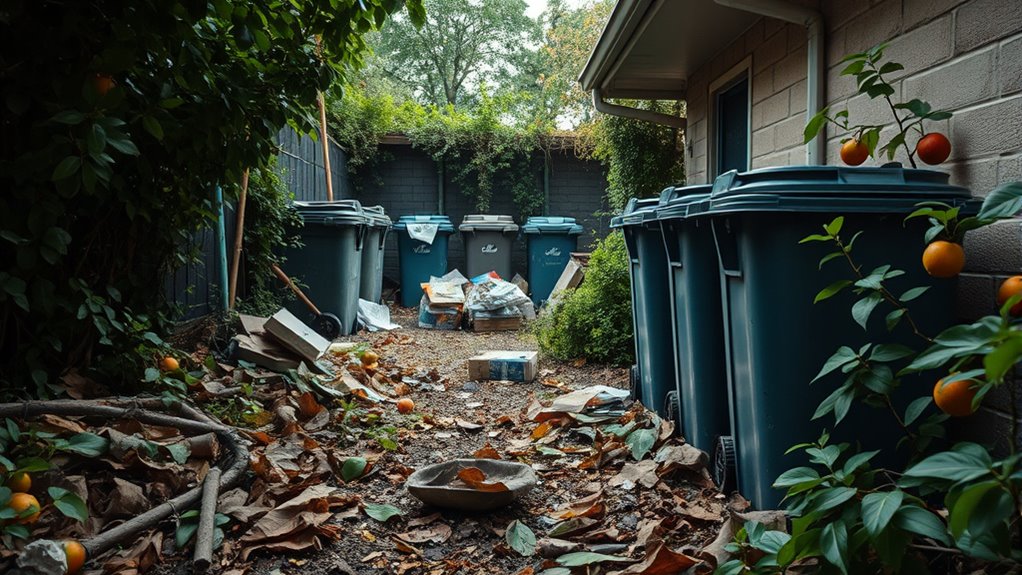
Ignoring prevention and sanitation measures allows pests to establish and flourish in your environment. Poor garden hygiene, like leaving debris or overgrown plants, creates hiding spots for pests and attracts unwanted insects. Failing to perform structural repairs, such as sealing cracks or fixing leaks, gives pests easy entry points and access to water sources. Without consistent sanitation, crumbs, spills, and clutter invite pests indoors. Neglecting these basic steps enables infestations to grow unchecked, making natural pest control efforts less effective. To prevent problems, maintain a clean environment, regularly prune your garden, and address structural vulnerabilities promptly. Proper prevention and sanitation are the foundation for a pest-free space, reducing the need for more invasive or chemical solutions down the line. Additionally, implementing air quality considerations like sealing entry points can help keep pests from entering your home.
Overlooking Natural Predators and Beneficial Insects
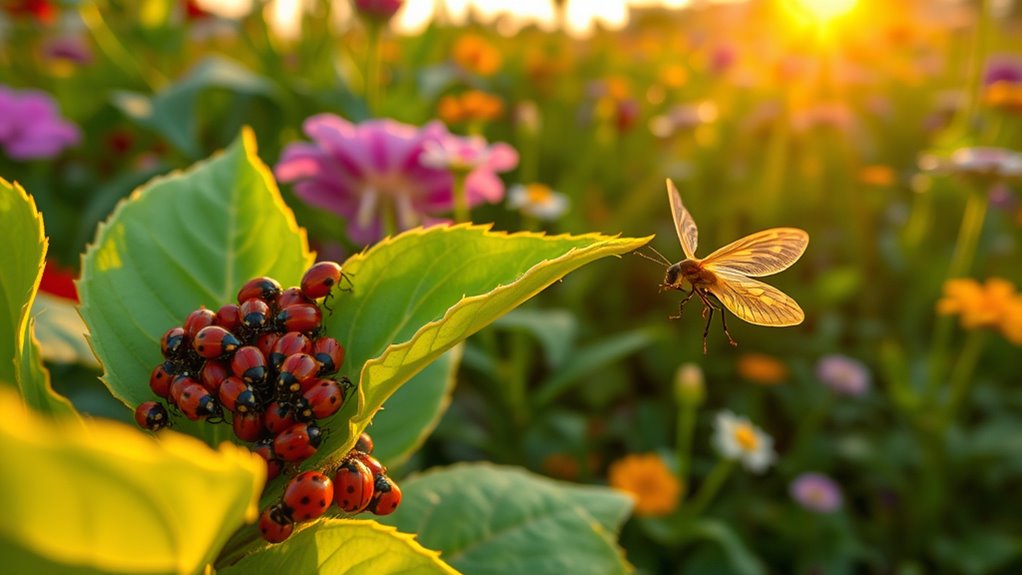
Many gardeners overlook the power of natural predators and beneficial insects in controlling pests. Increasing your natural predator awareness can substantially reduce the need for chemical interventions. To support beneficial insect conservation, consider these steps:
Boost your garden’s health by encouraging natural predators and beneficial insects.
- Avoid broad-spectrum pesticides that harm beneficial insects.
- Plant native species that attract natural predators.
- Provide habitats like insect hotels to encourage beneficial insect populations.
- Limit tilling and chemical use, which can disrupt predator-prey relationships.
- Incorporate integrated pest management strategies to balance pest control with ecological preservation.
Applying Natural Remedies Without Proper Research
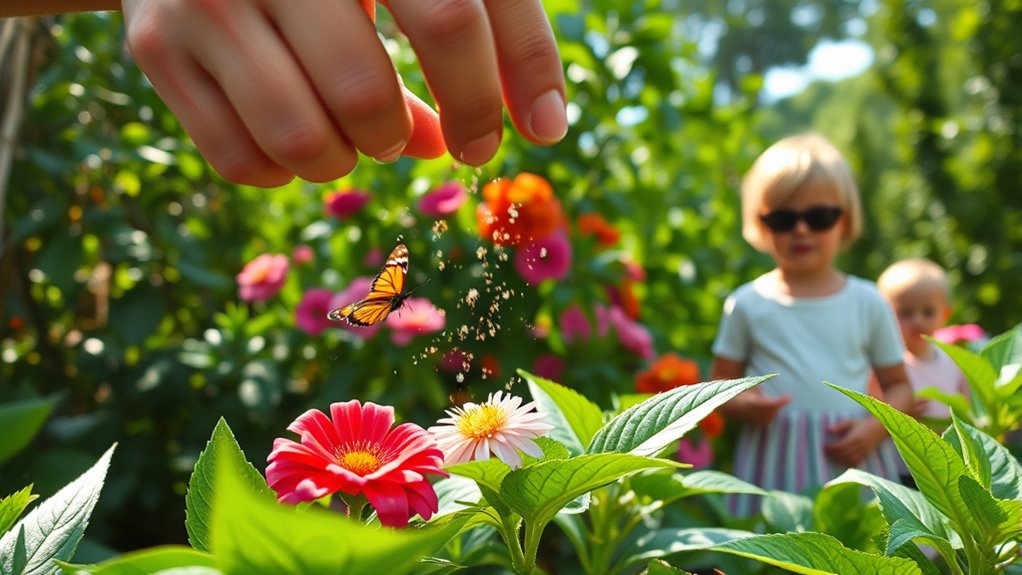
Applying natural remedies without doing your research can backfire, often causing more harm than good. Without proper research, you risk selecting ineffective or even harmful solutions. Targeted solutions are essential for safely managing pests, but applying remedies blindly can disrupt your garden’s balance or damage beneficial insects. Before trying anything, learn about the specific pest, its lifecycle, and suitable natural options. Use reliable sources to guarantee your approach is safe and effective. Additionally, understanding pest behavior can help you develop more precise and successful control strategies.
| Research Step | Purpose | Result |
|---|---|---|
| Identify the pest | Find targeted solutions | Reduce unnecessary treatments |
| Verify remedies | Ensure safety for plants and beneficial insects | Prevent collateral damage |
| Check application methods | Maximize effectiveness | Avoid misuse and waste |
| Follow expert advice | Achieve sustainable pest control | Long-term pest management |
Neglecting Regular Inspection and Monitoring
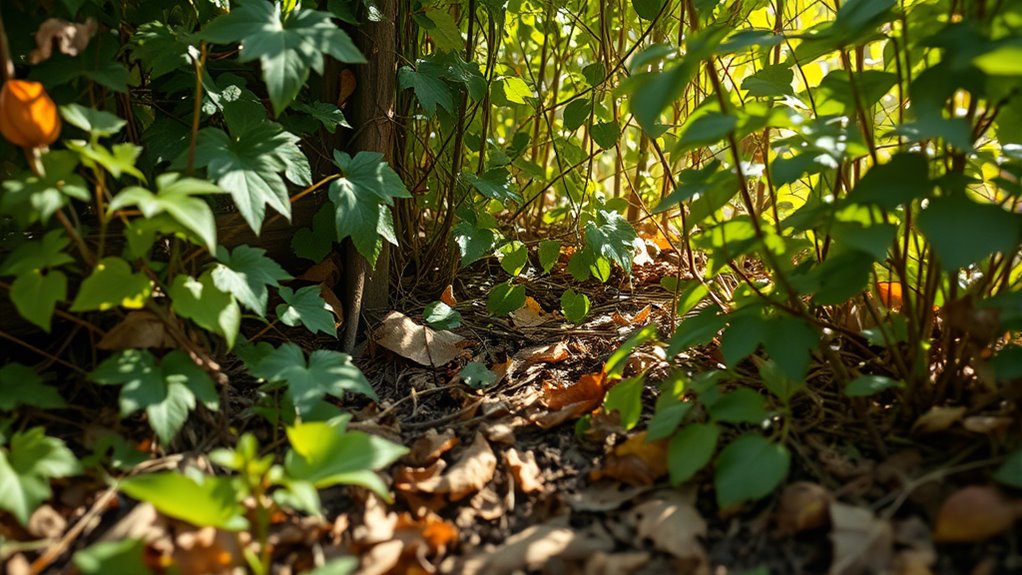
Regular inspection and monitoring are key to catching pest problems early before they escalate. Without consistent checks, you risk missing critical signs, impacting timing accuracy and pest identification. To improve your approach, consider these steps:
- Schedule routine inspections to spot issues at their onset.
- Use precise pest identification to determine the species involved.
- Track pest activity patterns to predict future outbreaks.
- Adjust control measures based on observed trends and accurate monitoring.
- Implement inspection protocols that incorporate environmental factors and pest behavior to enhance detection accuracy.
Neglecting this process allows pests to establish themselves, making control more difficult and costly. Regular monitoring not only helps identify pests early but also ensures you’re applying targeted, effective solutions at the right time, maximizing natural pest control efforts. Don’t overlook vigilant inspections; they’re your best defense.
Using Excessive Quantities of Natural Solutions

Using too much of a natural pest control solution can backfire, reducing its effectiveness and potentially harming your plants or the environment. Overuse of sprays may lead pests to build resistance, making them harder to eliminate over time. Excessive baiting can attract more pests than necessary, creating an imbalance that worsens the problem. Applying natural solutions in large quantities doesn’t mean better results; it often causes runoff, soil contamination, and harm to beneficial insects. Instead, use targeted, moderate amounts and follow recommended guidelines. Proper application guarantees you control pests effectively without risking damage to your garden or disrupting the ecosystem. Remember, more isn’t always better—strategic, measured use is key to successful natural pest management. Understanding pest resistance can help you develop more effective, sustainable strategies.
Relying on Single-Method Approaches Instead of Integrated Pest Management

Relying on just one pest control method can leave your garden vulnerable to ongoing infestations. You might think a single solution will solve everything, but pests often develop resistance or find new ways around it. To succeed, you need a balanced, integrated approach that targets pests at multiple points. Understanding different traits of pests and how they adapt is crucial for developing effective control strategies.
Overreliance on One Solution
Focusing on a single pest control method might seem easier, but it often leads to ineffective results and long-term problems. Relying solely on one approach fosters pesticide dependency and weakens your overall pest management. Monoculture farming, for example, increases vulnerability to pests, making a single method insufficient. Instead, adopt an integrated approach by:
- Combining biological controls with cultural practices
- Rotating crops to disrupt pest cycles
- Using targeted, eco-friendly interventions
- Monitoring pest populations regularly
Implementing diversified strategies not only enhances pest control but also promotes the health of your ecosystem. This strategy reduces overreliance on pesticides and creates a resilient system. By diversifying your tactics, you improve pest control efficiency and protect your environment, avoiding the pitfalls of monoculture farming and ensuring sustainable, natural solutions.
Ignoring Comprehensive Strategies
When you depend on a single pest control method, you risk leaving your entire strategy vulnerable to pests that adapt or resist that approach. A all-encompassing approach, combining integrated methods, is far more effective. Relying solely on one technique, like traps or natural repellents, ignores the complexity of pest behavior and their ability to develop resistance. Instead, you should adopt an integrated pest management plan that includes cultural, biological, and physical controls. This extensive strategy reduces pest populations sustainably and minimizes the chance of pests adapting to any one method. By thinking holistically, you address the root causes of infestations and create a balanced environment. Incorporating diversification benefits into your pest control approach ensures a more resilient and effective strategy. Ignoring these comprehensive strategies might give quick results temporarily but ultimately leaves your home or garden exposed.
Disregarding Plant and Soil Health in Pest Control Strategies
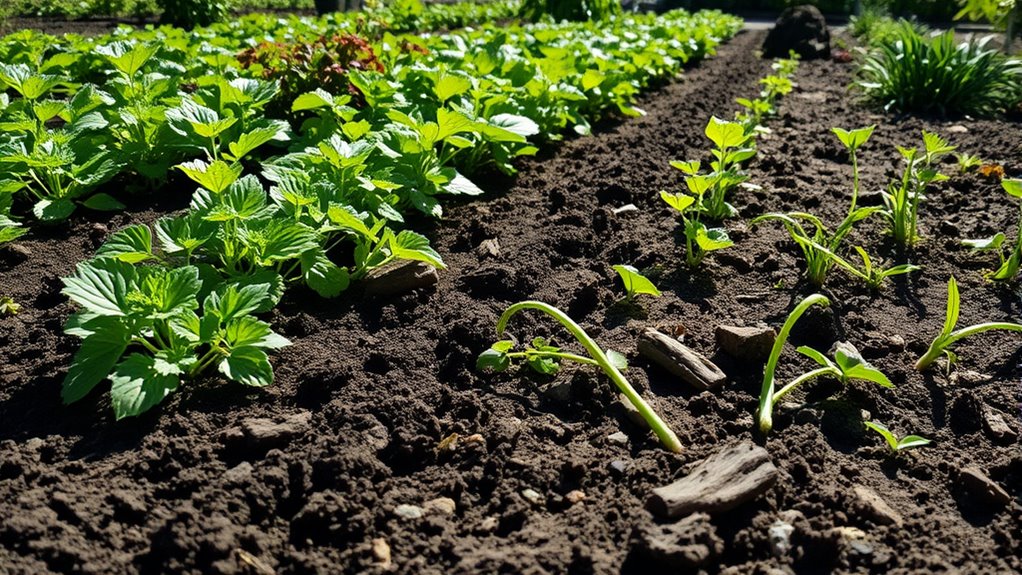
Ignoring the health of your soil and plants can undermine your pest control efforts. When you neglect soil microbes, plant resilience, and ecosystem relationships, pests find more opportunities to thrive. Prioritizing soil and plant robustness is key to sustainable, natural pest management. In fact, understanding optimal angles for pinball machines can inspire more effective strategies for creating a balanced garden ecosystem.
Overlooking Soil Microbes Balance
Neglecting the balance of soil microbes can undermine your pest control efforts, as these tiny organisms play a crucial role in maintaining plant health and suppressing pests naturally. When microbial diversity declines, plants become more vulnerable to pests and diseases. To foster healthy soil microbes, consider:
- Avoiding synthetic chemicals that harm microbial life
- Incorporating organic matter like compost to boost microbial diversity
- Practicing crop rotation to prevent soil depletion
- Minimizing soil disturbance to preserve microbial habitats
Additionally, understanding soil microbial balance can help you implement more effective and sustainable pest management strategies.
Neglecting Plant Resilience Building
Building plant resilience is essential for effective pest management, yet many gardeners overlook this aspect in their strategies. When you ignore strengthening your plants and soil health, you weaken the overall ecosystem health. Healthy plants naturally resist pests better because their robust defenses deter invasions. By neglecting plant resilience, you miss the opportunity to create a resilient system that can recover quickly from pest damage. Instead of relying solely on reactive measures, focus on cultivating strong, healthy plants through proper watering, nutrient management, and composting. This approach enhances ecosystem health, making your garden less inviting to pests and reducing the need for intervention. Prioritizing plant resilience builds a natural buffer, supporting long-term pest control and overall garden vitality. Incorporating natural materials such as sustainable and eco-friendly Waldorf toys can also inspire a holistic approach to gardening, emphasizing harmony with nature and long-lasting health.
Ignoring Ecosystem Interactions
When you overlook the connections between plants and soil health, your pest control strategies often fall short. Ignoring ecosystem interactions disrupts the natural balance and hampers biodiversity preservation. This oversight can lead to increased pest problems and degraded soil quality. To improve, consider these steps:
- Support diverse plantings to enhance ecosystem balance.
- Maintain healthy soil through organic practices.
- Promote beneficial insects that naturally control pests.
- Avoid chemical reliance that damages soil and ecosystem stability.
- Incorporate soil microbiome management techniques to foster a resilient environment that naturally suppresses pests.
Failing to Educate Yourself About Pest Behavior and Lifecycle
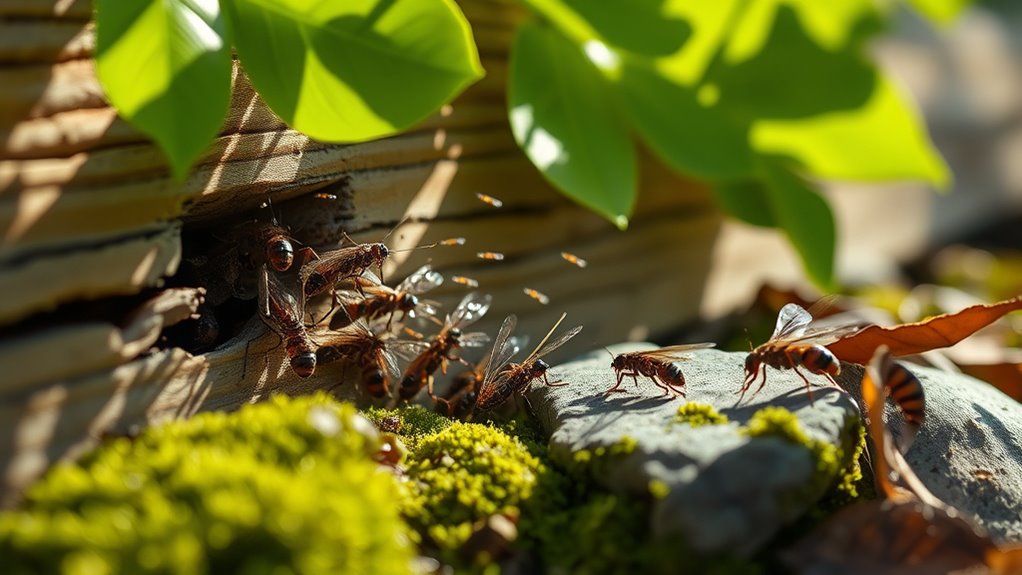
Understanding the behavior and lifecycle of pests is essential for effective natural control. Without this knowledge, you risk using methods that don’t target pests at the right stage or overlook their behavior patterns. Knowing a pest’s lifecycle helps you identify when they’re most vulnerable, such as during egg or larval stages. For example, some pests lay eggs in hidden spots, making early detection vital. Failing to educate yourself means you might misidentify pests or apply unnecessary interventions, wasting time and effort. By learning about their lifecycle and behavior patterns, you can develop targeted strategies that disrupt their reproduction or movement. This approach not only improves your pest management but also minimizes harm to beneficial insects and the environment. Education is your most powerful tool in natural pest control.
Frequently Asked Questions
How Can I Identify the Specific Pest Attacking My Plants?
Pinpoint pests by closely inspecting plant damage and pest signs. Look for telltale trails, tiny tunnels, or unusual markings on leaves, stems, and roots. Notice pests themselves—beetles, bugs, or caterpillars—or their eggs and droppings. Take a magnifying glass and examine suspect areas to identify specific pests, helping you choose targeted, natural pest control. Recognizing these clues transforms trouble into targeted, timely treatments.
What Are the Most Effective Natural Predators for Common Pests?
You should introduce beneficial insects like ladybugs, lacewings, and predatory beetles to control common pests naturally. These predator species target aphids, mealybugs, and scale insects effectively. By releasing or attracting these beneficial insects to your garden, you create a natural pest management system that reduces the need for chemical treatments. Always research which predator species target your specific pests for the best results.
How Often Should I Inspect My Garden for Pest Activity?
You should inspect your garden at least twice a week to catch pest activity early. Studies show that regular pest monitoring reduces infestations by up to 50%. Use timing strategies, such as inspecting during dawn or dusk when pests are most active, to maximize effectiveness. Consistent checks help you identify issues quickly, allowing natural predators to work effectively and preventing pest populations from spiraling out of control.
Are There Any Eco-Friendly Natural Pesticides I Should Avoid?
Yes, you should avoid eco-friendly natural pesticides that contain chemical residues or synthetic formulations, as they can harm beneficial insects and the environment. Instead, opt for pure, plant-based solutions like neem oil or insecticidal soaps, which are effective yet gentle. Always read labels carefully to guarantee there are no hidden synthetic ingredients, and remember that natural doesn’t always mean completely chemical-free. Your goal is safe, effective pest control that aligns with eco-friendly practices.
How Does Soil Health Influence Pest Populations?
Just like a good knight values his armor, you should focus on soil health to control pests naturally. When soil nutrition is balanced, it supports beneficial microbes that keep pest populations in check. A healthy microbial balance prevents pests from overrunning your garden, reducing the need for chemical interventions. So, tend to your soil as you would a treasured relic, and watch your garden thrive with fewer pest problems.
Conclusion
So, next time you’re tempted to spray, trap, or guess, remember: pest control’s not a one-night stand. Dig deeper, understand your pests’ secret lives, and embrace a balanced approach. After all, who knew that respecting nature’s own signs and rhythms could save you from a never-ending cycle of DIY disasters? Trust me, your plants—and your sanity—will thank you for stopping the madness and doing it right. Happy pest hunting!
